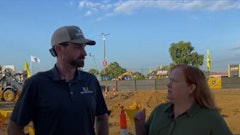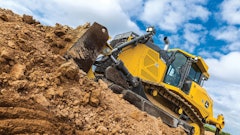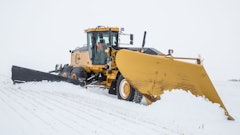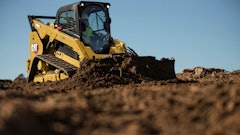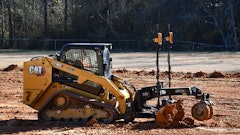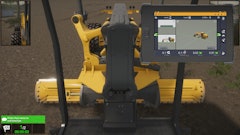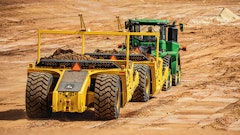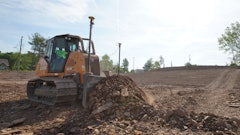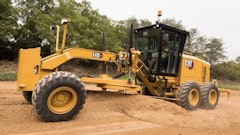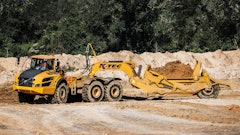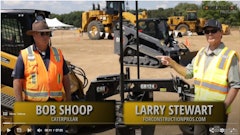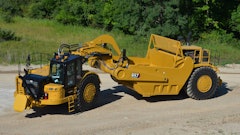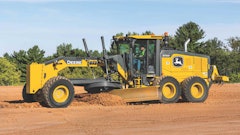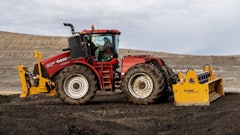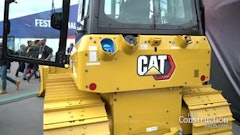If used in the right soil conditions with the correct scraper train and scraper tractor, a pull scraper system promises to move material faster with less initial investment, less support equipment, fewer operators and lower operating costs compared to conventional methods.
Mike McCrory, Eastern regional sales manager, Miskin Scraper Works, says the biggest advantage comes from the system's ability to work without support equipment. "It loads itself with no help from a crawler dozer and unloads itself while dumping on grade, negating the need for a crawler dozer to smooth out the dump area," he points out.
But you really have to know what you're doing to realize the savings. Bennington Equipment, a John Deere dealer, made the decision several years ago to get into the scraper business. "Basically, we jumped in with both feet, and a lot of the things we tried didn't work," says Brad League, scraper product specialist. "They cost us a lot of money. It took a period of years to learn everything."
This experience now cuts the learning curve for Bennington Equipment's customers. "Now that we have that experience, we try to set up customers properly," says League.
When exploring pull scraper systems, look for a supplier that can provide practical jobsite experience. Sometimes small mistakes in the setup result in an unfavorable experience. "Maybe if you used a different tire or a different scraper, you may have been satisfied," League notes.
Addressing limitations
Pull scrapers have evolved. "They are tending to get a little easier to load and a lot less maintenance," says Allan Clark, president, Clark Bros. Inc., Dos Palos, CA, a construction and land leveling company that constructs building pads, drains and canals, etc. Its equipment fleet includes both motor wheel scrapers and pull scraper systems.
Clark feels today's pull scrapers have become more durable. "We had a lot of trouble with bending them in really hardpan conditions," he notes. "We don't have as much problem today as we did."
Pull scraper systems are also overcoming one of their traditional drawbacks - top speed limitations of the scraper tractors. "In some cases, when the haul is longer than one mile, the contractor may opt to use excavators or conventional scrapers," says James Hausner, vice president of marketing, Reynolds International. "However, many opt for pulling up to three units per tractor. As far as speed and gradeability, motor wheel scrapers can run as fast as 30+ mph, whereas tractors average around 23 mph, with some exceptions."
Those exceptions include industrial tractors that are capable of pulling scrapers at speeds comparable to a motor wheel scraper. "With the introduction of the new high-speed industrial tractors, the haul distance is no longer a factor," says McCrory. "The two most prevalent trends are the use of higher capacity pull scrapers, and the use of industrial tractors specially built for pull scrapers."
Mission Paving Co., Mission, TX, has found pull scraper systems a highly effective way to move soil. The site work contractor owns four self-propelled elevator scrapers, plus three tandem Reynolds 12C scraper rigs and a tandem 17C scraper rig - all pulled by 8000 Series John Deere tractors.
"The elevator scrapers are used in applications where we need to pick up dirt that has either been moved or handled by another machine, or to clean up an area and move the dirt," says David Valadez. "The elevator scrapers are very high maintenance in comparison and the annual expenditures are quite a bit more vs. the pull scrapers."
This is reflected in the usage. "We probably run between 300 to 500 hours a year on each of our elevated scrapers, where we run 1,500 to 2,500 hours with each of our tractors [with scrapers]," says Valadez.
The pull scrapers have proven to be high-production tools. Soil conditions on jobsites vary from heavy clays to sandy soils, and most cuts are done at between 3.5 and 4.5 mph. Given a 300-yd. haul distance, Valadez reports he can move 2,000 yds. a day with the 12-yd. tandem pull scraper rigs, and 3,000 yds. a day with the tandem 17-yd. scraper rigs.
The rigs have all proven reliable. "It is not that we don't have any problems at all, but they are very durable, and they can be rebuilt and will work just as good as a brand new one," says Valadez.
Conditions dictate choice
No pull scraper system is right for every application. "Tractors and scrapers can be configured differently to adapt to the various soil types," says Mat Zeringue, product consultant, Deere & Company. "While ejector scrapers perform better in heavier clays, carry-alls are the choice for sand. Both models can perform well in mixed soils."
The ability to handle heavier soils makes the ejector scraper a versatile tool. "We are seeing more commercial operations moving toward our ejector models," says Michael Rieth, product consultant, Deere & Company. "The various blade configurations and versatility in heavy soils are some of the benefits of this model that provide significant value to our customers. We are also seeing some of our customers wanting to pull larger single scraper rigs."
Clark Bros. Inc. runs Reynolds ejector scrapers. "We were quite happy when we converted to the ejector scrapers because they work so much better in wet material," Clark states. "You could actually go back to work two or three days earlier after a rain with the ejector than you could with the tip scraper."
Then the contractor tried a narrow Reynolds 17E scraper. "It is only 10 1/2 ft. wide as opposed to the 14-ft. models that we had," says Clark. "It is a little easier loading and it hauls a little more dirt."
He was convinced this was the way to go until he tried the 15C tip scraper. "We haven't worked it yet in really wet conditions to know if there is a problem," he says, "but my operators tell me it dumps better than the old one did. It is easier loading yet."
One drawback of narrow scrapers has been finish grade work. "They could load quicker and dump better, but they were not as good for finish grading because they were narrow," says Clark. "The 15C is a little wider and easy loading. So now we are thinking that is the rig we want."
Material appetite really dictates what type of earthmoving system will work best given your soil conditions. "Any soil can be loaded with a pull scraper as long as the concentration of rocks is less than that of the dirt," says McCrory.
But hardpan and rock prove difficult for pull-scraper systems. "They don't work well in rock and real hard hardpan," says Clark. "Even though they are stronger now than they used to be, you will still bend them up."
When the ground is hard, self-propelled scrapers have a definite advantage. "They have the capability to put a lot more horsepower to the ground," says League. "You can push them with a dozer or they can push each other with a push/pull. There are parts of the country where there is more rock. You really have to push that horsepower up and get into that rock. There is a lot more steel in the self-propelled scrapers. They are certainly more durable."
Confined spaces also favor the use of self-propelled scrapers. Pull scrapers really need room to operate. "They are best suited for large quantity, large sites," says League.
Clark has four self-propelled scrapers for tighter conditions and harder-loading material. "There are places where the [self-propelled scraper] is just ideal, and conditions where you can't get two pull scrapers and a tractor into," says Clark. But he prefers the pull scrapers when there is ample room. "For cost of operation, those tandem scrapers will move almost the same amount of dirt and they will run for almost half the cost. The repair costs on the self-propelled scrapers are so high."
Pull scrapers also allow operation in adverse weather conditions. When ground conditions get soft, top-loading pull scrapers will keep things moving.
Use good judgment
League advises customers not to buy into hype that sounds too good to be true. "One mistake customers make is they buy the first thing that is being sold and it comes with a really big promise," he comments. There are some companies that promise unrealistic volumes of material moved per cycle. "The better it sounds, the more cautious you should be."
Bennington Equipment has bought into the hype of a new product in this market more than once, and it didn't meet the expectations. "We offered an unknown brand," says League. "It looked heavy, and at the time it was very inexpensive. I tried to rent the machines and they basically broke every other day. There were minor problems nagging constantly. You think you are saving money and it ends up costing a lot more in the long run."
Pull scrapers have the potential to save on earthmoving costs when used in the right applications. But do your homework and work with companies that have a proven record of success. ?
Cost Conscious The price for a pull scraper system is significantly less than for a self-propelled scraper. "You are between 50% to 70% less, depending upon your configuration," says Brad League, Bennington Equipment. You also need to factor depreciation into the equation. All new equipment will depreciate a lot initially. "When you have a three-quarters of a million dollar machine that depreciates 30%, that is a lot bigger than a $300,000 machine when it depreciates by 30%," League asserts. There are also substantial differences in operating costs. "There have been many fuel consumption tests to verify that tractor-scraper combinations use less fuel than motor wheel scrapers," says Mike McCrory, Miskin Scraper Works. "There are several factors that account for the difference in operating cost. But I suppose the main factor is the contractor is hauling a much larger payload with less horsepower." One power unit can pull a scraper train with a large earthmoving capacity. "A tractor-scraper combination requires one operator and can pull as many as three scrapers yielding anywhere from 30 to 60 cu. yds. of material, without the need for any support equipment," says James Hausner, Reynolds International. The trade-off is that a self-propelled scraper places more horsepower to the ground. This can be a benefit in very hard soil conditions. When you factor in the fuel consumption and support equipment requirements, a pull scraper used in the proper environment can yield substantial savings. "We at Deere say half the labor, one-third the investment and $.30 to $.50/yd. savings when compared to other modes of moving material," says Mat Zeringue, Deere & Company. "The information, validated by customers, is that one operator can load, carry, fill and compact with one system. The difference in operating cost is the number of operators, the support equipment, the number of engines burning fuel and the increased carrying capacities of pull-type scrapers." Depending on the configuration used, the difference in the amount of fuel burned can be sizable. "A 450- to 500-hp tractor can burn 15 to 16 gph," says League. A comparable self-propelled scraper may use 22 to 30 gph, depending on the model. |
Technique Required Speed is critical when loading a pull scraper. "They load easier if you speed up," says Allan Clark, Clark Bros. Inc. "It pushes the dirt up faster and higher into the scraper than if you are just barely moving. Of course, when you are going slower, you can cut a little deeper, but you don't get loaded any faster." Don't try to cut as deep as you would with a motor wheel scraper. "Pull scraper systems are designed to make shallower but smoother cuts, negating the need for any support equipment," says Mike McCrory, Miskin Scraper Works. James Hausner, Reynolds International, agrees, adding, "Reynolds recommends shallow cuts of 2 to 3 in. in order to maintain a smooth surface." According to Kent Stickler, product consultant, Deere & Company, the depth of cut is dictated by the material and scraper width. "In our operator training, we focus on keeping the engine around 1,900 rpm for full power boost during loading, and load as fast as possible," he notes. "We also say cut the material off the top; don't dig off the bottom. Doing so will provide faster loading and faster cycle times. The load on the tractor is going to dictate if the scrapers are deep or shallow." Training should be a priority, even for experienced motor wheel scraper operators. "Conventional scraper operators, after limited training, are productive in moving material with a pull pan system," says Michael Rieth, Deere & Company. "Where they might have been pushed before, now they are controlling the loading depth of the scraper as one unit. The loading speeds are faster, and once the front scraper is full, the operator needs to feel or hear the second scraper going in the ground. At the fill, the operator needs to learn to dump multiple scrapers instead of one. And just like a conventional scraper, for a well-managed fill area, dump height is important." While many pull scraper manufacturers claim they take less skill to run than a self-propelled scraper, not everyone agrees. "It takes a good amount of skill to run either one," says Clark. "When you get two pull scrapers on there, you have your hands full." As with anything else, it takes practice. "Like playing a fine instrument, there is a touch to it," says David Valadez, Mission Paving Co. "It just has to come with time. You listen to the motor. You feel the pull. The hydraulic system is set up to where it reacts to the touch you give the lever. It does not take a lot of training, but it takes a little time until you gather the touch of handling it." League concludes, "It takes an equal amount of skill. It is obvious that a better skilled operator is more productive." |




